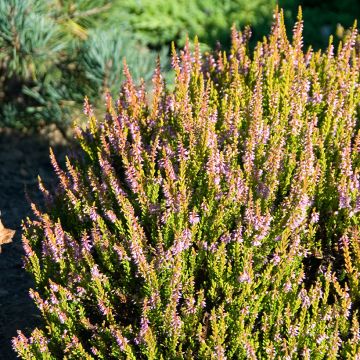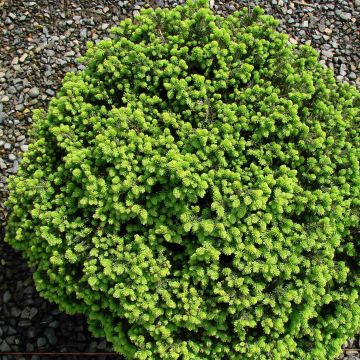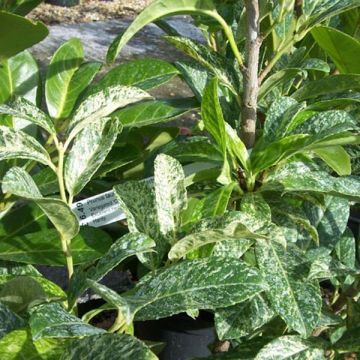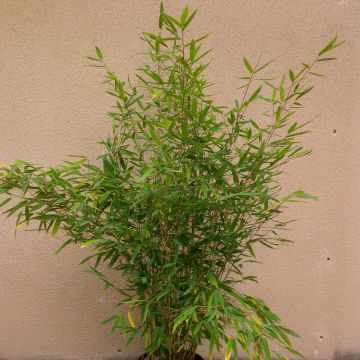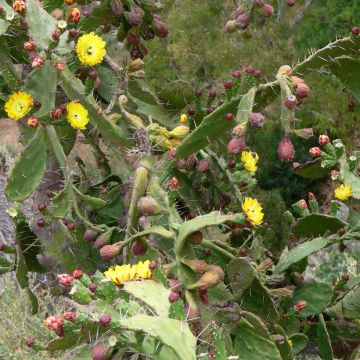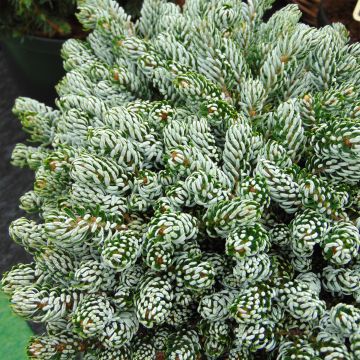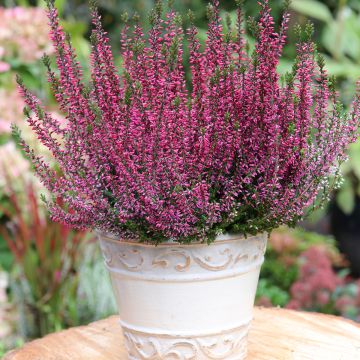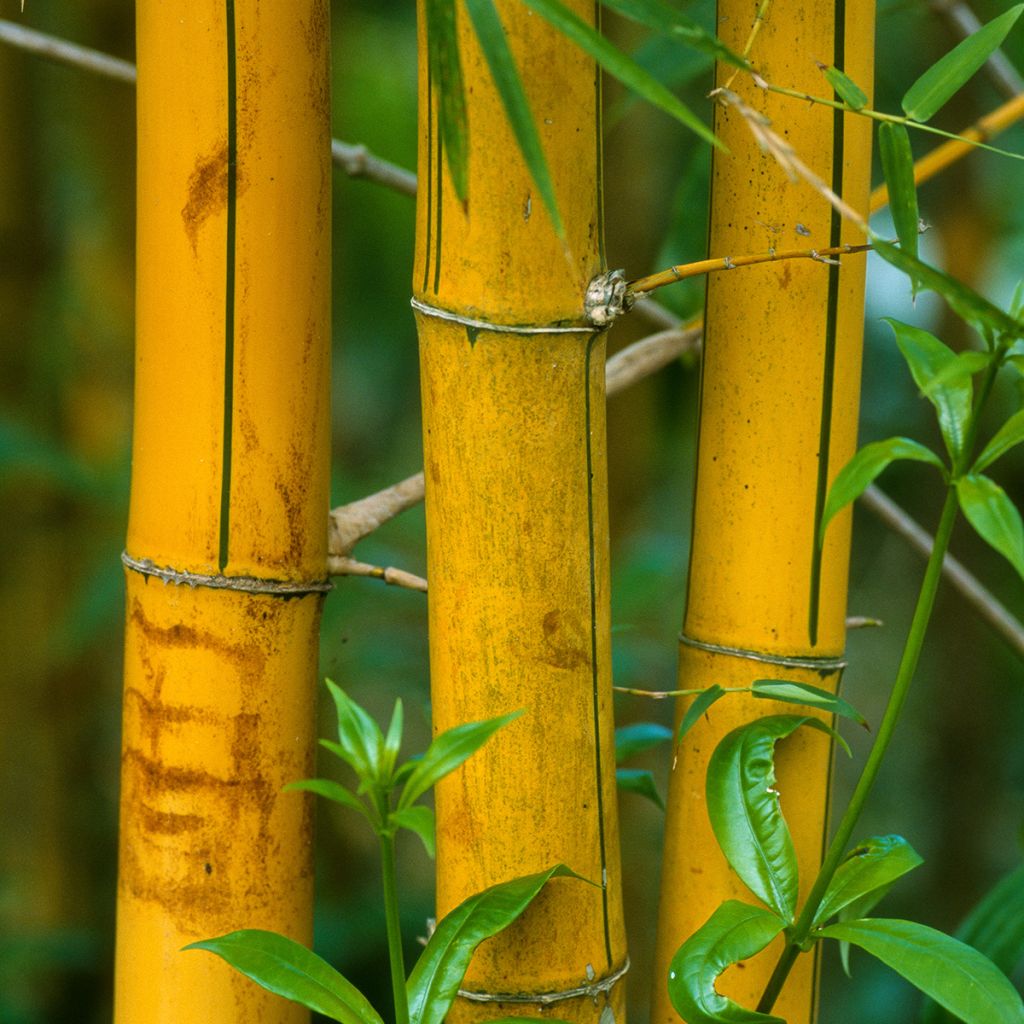

Phyllostachys viridis Sulphurea - Golden Chinese Bamboo


Phyllostachys viridis Sulphurea - Golden Chinese Bamboo


Phyllostachys viridis Sulphurea - Golden Chinese Bamboo
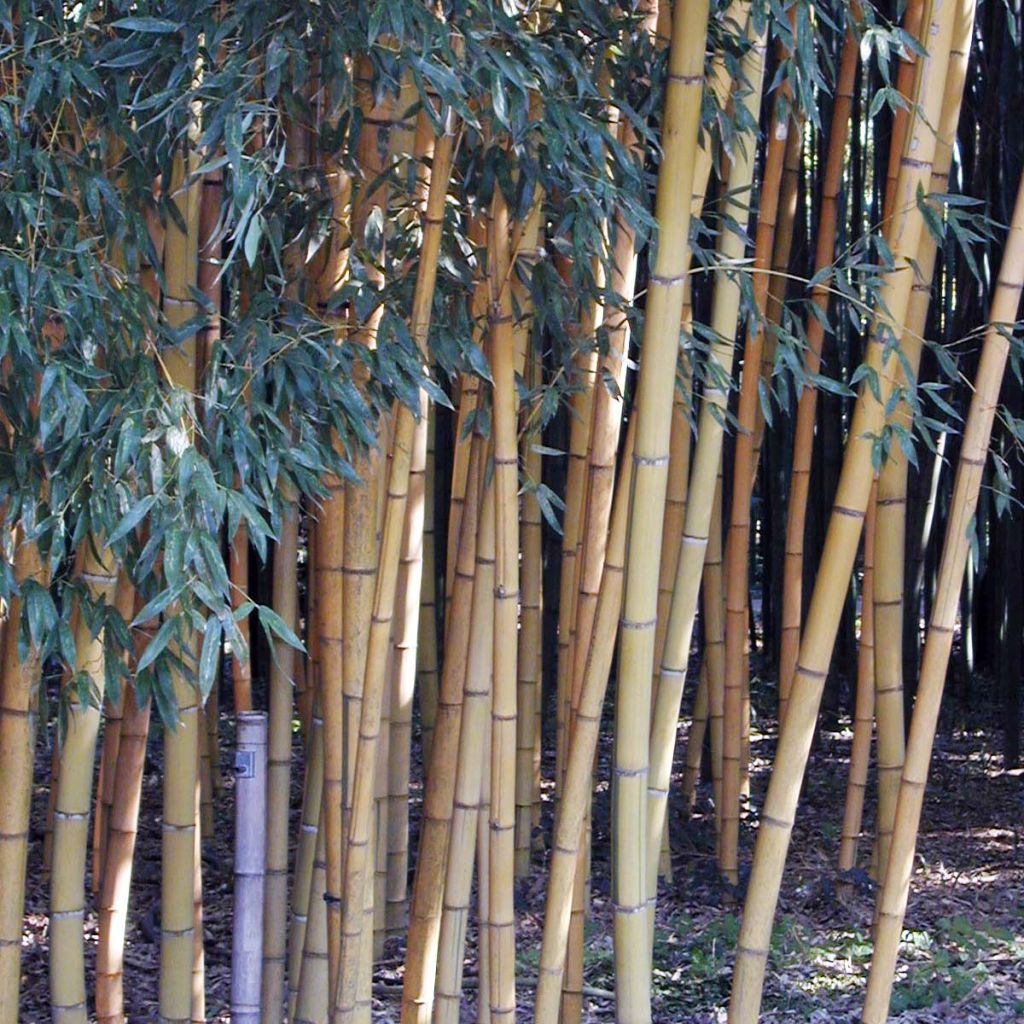

Phyllostachys viridis Sulphurea - Golden Chinese Bamboo
Phyllostachys viridis Sulphurea - Golden Chinese Bamboo
Phyllostachys viridis Sulphurea (Robert Young)
Golden Chinese Bamboo
Beautiful young plant with large vine-plants, received on D+1 after ordering, very very satisfied with the relationship with Promesse de fleurs. I highly recommend and talk about it to those around me, they are true professionals for a passionate person like me.
Stephane, 17/06/2021
Special offer!
Receive a €20 voucher for any order over €90 (excluding delivery costs, credit notes, and plastic-free options)!
1- Add your favorite plants to your cart.
2- Once you have reached €90, confirm your order (you can even choose the delivery date!).
3- As soon as your order is shipped, you will receive an email containing your voucher code, valid for 3 months (90 days).
Your voucher is unique and can only be used once, for any order with a minimum value of €20, excluding delivery costs.
Can be combined with other current offers, non-divisible and non-refundable.
Home or relay delivery (depending on size and destination)
Schedule delivery date,
and select date in basket
This plant carries a 24 months recovery warranty
More information
We guarantee the quality of our plants for a full growing cycle, and will replace at our expense any plant that fails to recover under normal climatic and planting conditions.

Would this plant suit my garden?
Set up your Plantfit profile →
Description
The Phyllostachys viridis Sulphurea is a very beautiful bamboo that will only become giant if it benefits from warmth. Sensitive to excess water, this variety is one of the few that adapts to mediocre, clay, poor or occasionally dry soils. It is recognized by its powerful, sinuous and rough canes, barely streaked with dark green, changing from tender green to sulfur yellow or golden yellow over time, and its dense light green foliage. Resistant to cold, spreading, it can be grown in the ground as an isolated clump or in a grove, and allows for the creation of superb windbreaks. It also thrives in pots or containers and its young shoots are edible raw or cooked.
Originally from southeast China, Phyllostachys viridis Sulphurea is a tall bamboo with spreading rhizomes and rapid growth in warm climates. It belongs to the family of poaceae (or grasses), it is a kind of giant grass with woody stems.
It has an upright habit and carries low leafy branches on individual canes exposed to the sun. In spring, at the end of May or beginning of June, it produces numerous stems or canes reaching 4 to 10cm (3.9in) in diameter and 7.50m (23 ft) to 15m tall depending on the climate. The more the plant benefits from warmth, the more it develops. Each cane or stem has a sinuous appearance, accentuated by fairly short internodes. They emerge from the ground covered with a black marbled sheath. The colour of the young stems is a pale green marked by scattered dark green dashes. They are covered with a white-blue bloom, especially at the nodes. Over time, the green colour gradually turns yellow, even golden yellow if the canes are exposed to the sun, while they take on a slightly lumpy "orange peel" appearance. The evergreen foliage is composed of medium-sized leaves, light green, sometimes streaked with yellow. They are narrow and lanceolate, tapering at their tips. Perfectly hardy, this bamboo withstands temperatures of at least down to -18°C (-0.4°F).
Phyllostachys Sulphurea is often planted as an isolated clump, in a grove or as a natural hedge. When the climate suits it, it becomes spectacular and extremely decorative, with shades of yellow and green. In a contemporary-style garden, it can be paired with certain palm trees and large ornamental grasses such as pennisetums, deschampsias, or miscanthus. It can be associated with other bamboos such as Phyllostachys bambusoides Castillonis, with yellow stems striped with green, but also with Phyllostachys aurea Holochrysa or even black bamboo, playing with the colours of the canes. Its young shoots are edible and its canes, whose resistance can be compared to that of steel, are often used as stakes or for the construction of pergolas and fences. It adapts well to container cultivation, shaping its development. In this use, it is a very beautiful conservatory or orangery plant.
Tip: Limit the proliferation of the spreading rhizomes of this bamboo by installing "anti-rhizome barriers" from the time of planting, which are resin plates planted vertically in the ground.
Report an error about the product description
Phyllostachys viridis Sulphurea - Golden Chinese Bamboo in pictures
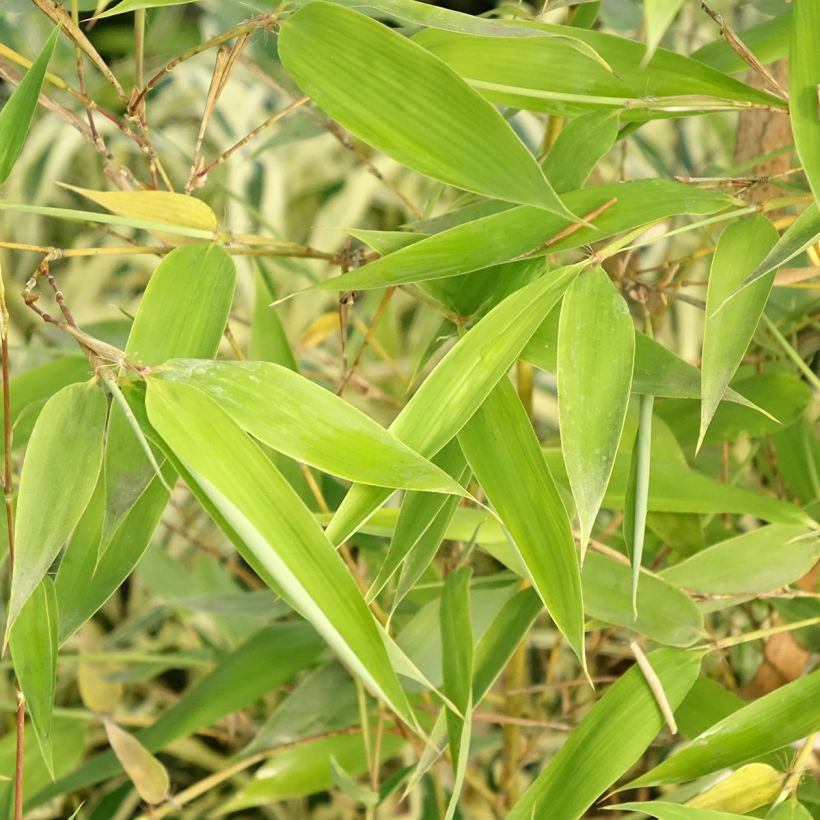

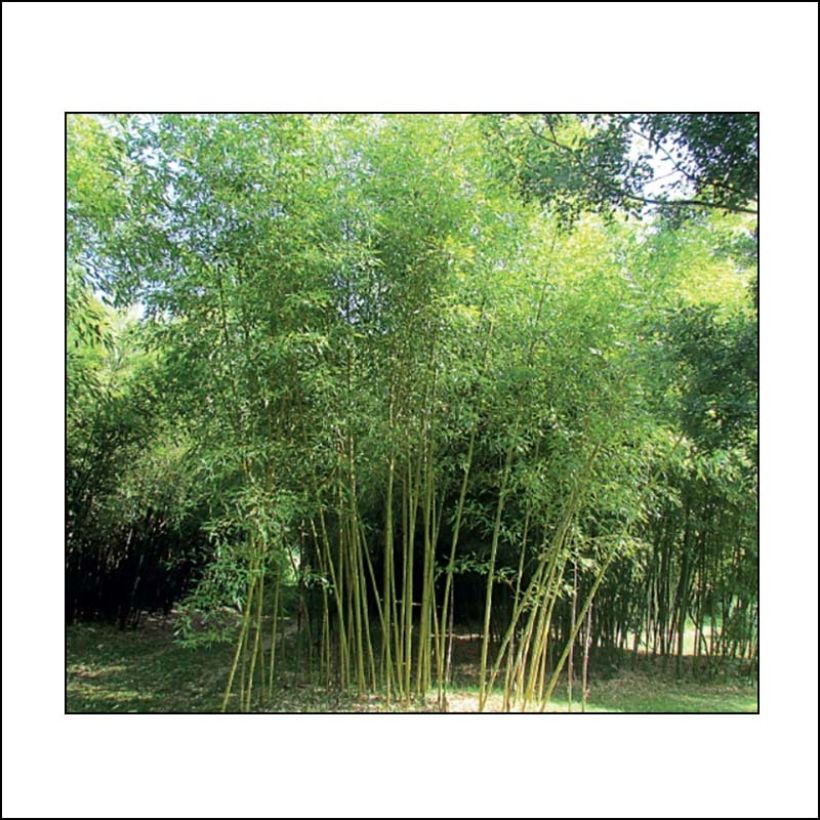

Plant habit
Foliage
Botanical data
Phyllostachys
viridis
Sulphurea (Robert Young)
Poaceae
Golden Chinese Bamboo
China
Planting and care
Grown in containers, bamboos can be planted at any time of the year, except during frost. However, the best planting period is late summer and autumn, when the soil is warm and rainfall is more frequent. The planting distance depends on how you will use your bamboos: for a mass planting, allow a gap of 3 to 4 meters between each plant. For a hedge, this distance is reduced to 1.6 to 2 metres.
In general, bamboo prefers rich, deep, well-drained soil that remains moist, acidic or neutral. They can tolerate slightly alkaline soil, depending on the varieties. The Phyllostachys viridis Sulphurea appreciates heat and sunlight but can tolerate partial shade. It performs well in clay or even dry soil, but it dislikes excessive water that causes its rhizomes to rot.
During planting, loosen the soil and moisten the root ball well by soaking it. You can add well-rotted compost and rake it into the surface. Watering should be done regularly for at least the first year in open ground and continued if your bamboo is grown in a pot. The establishment period may seem a bit long, but don't panic!
For bamboo with running rhizomes, the installation of a rhizome barrier (thick and resistant polypropylene film) is essential because these varieties, which disregard the notion of property limits, can quickly colonize large areas. The rhizome barrier should be buried vertically, leaving a height of 10cm (3.9 inches) exposed and inclined at a 15-degree angle towards the plant.
In terms of maintenance, bamboo is not demanding: remember to weed around the base, at least in the early stages until the dead leaves on the ground form a natural mulch. A nitrogen-rich fertilizer (well-rotted manure or liquid fertilizer) in spring and autumn can be beneficial.
Planting period
Intended location
Care
-
, onOrder confirmed
Reply from on Promesse de fleurs
Similar products
Haven't found what you were looking for?
Hardiness is the lowest winter temperature a plant can endure without suffering serious damage or even dying. However, hardiness is affected by location (a sheltered area, such as a patio), protection (winter cover) and soil type (hardiness is improved by well-drained soil).

Photo Sharing Terms & Conditions
In order to encourage gardeners to interact and share their experiences, Promesse de fleurs offers various media enabling content to be uploaded onto its Site - in particular via the ‘Photo sharing’ module.
The User agrees to refrain from:
- Posting any content that is illegal, prejudicial, insulting, racist, inciteful to hatred, revisionist, contrary to public decency, that infringes on privacy or on the privacy rights of third parties, in particular the publicity rights of persons and goods, intellectual property rights, or the right to privacy.
- Submitting content on behalf of a third party;
- Impersonate the identity of a third party and/or publish any personal information about a third party;
In general, the User undertakes to refrain from any unethical behaviour.
All Content (in particular text, comments, files, images, photos, videos, creative works, etc.), which may be subject to property or intellectual property rights, image or other private rights, shall remain the property of the User, subject to the limited rights granted by the terms of the licence granted by Promesse de fleurs as stated below. Users are at liberty to publish or not to publish such Content on the Site, notably via the ‘Photo Sharing’ facility, and accept that this Content shall be made public and freely accessible, notably on the Internet.
Users further acknowledge, undertake to have ,and guarantee that they hold all necessary rights and permissions to publish such material on the Site, in particular with regard to the legislation in force pertaining to any privacy, property, intellectual property, image, or contractual rights, or rights of any other nature. By publishing such Content on the Site, Users acknowledge accepting full liability as publishers of the Content within the meaning of the law, and grant Promesse de fleurs, free of charge, an inclusive, worldwide licence for the said Content for the entire duration of its publication, including all reproduction, representation, up/downloading, displaying, performing, transmission, and storage rights.
Users also grant permission for their name to be linked to the Content and accept that this link may not always be made available.
By engaging in posting material, Users consent to their Content becoming automatically accessible on the Internet, in particular on other sites and/or blogs and/or web pages of the Promesse de fleurs site, including in particular social pages and the Promesse de fleurs catalogue.
Users may secure the removal of entrusted content free of charge by issuing a simple request via our contact form.
The flowering period indicated on our website applies to countries and regions located in USDA zone 8 (France, the United Kingdom, Ireland, the Netherlands, etc.)
It will vary according to where you live:
- In zones 9 to 10 (Italy, Spain, Greece, etc.), flowering will occur about 2 to 4 weeks earlier.
- In zones 6 to 7 (Germany, Poland, Slovenia, and lower mountainous regions), flowering will be delayed by 2 to 3 weeks.
- In zone 5 (Central Europe, Scandinavia), blooming will be delayed by 3 to 5 weeks.
In temperate climates, pruning of spring-flowering shrubs (forsythia, spireas, etc.) should be done just after flowering.
Pruning of summer-flowering shrubs (Indian Lilac, Perovskia, etc.) can be done in winter or spring.
In cold regions as well as with frost-sensitive plants, avoid pruning too early when severe frosts may still occur.
The planting period indicated on our website applies to countries and regions located in USDA zone 8 (France, United Kingdom, Ireland, Netherlands).
It will vary according to where you live:
- In Mediterranean zones (Marseille, Madrid, Milan, etc.), autumn and winter are the best planting periods.
- In continental zones (Strasbourg, Munich, Vienna, etc.), delay planting by 2 to 3 weeks in spring and bring it forward by 2 to 4 weeks in autumn.
- In mountainous regions (the Alps, Pyrenees, Carpathians, etc.), it is best to plant in late spring (May-June) or late summer (August-September).
The harvesting period indicated on our website applies to countries and regions in USDA zone 8 (France, England, Ireland, the Netherlands).
In colder areas (Scandinavia, Poland, Austria...) fruit and vegetable harvests are likely to be delayed by 3-4 weeks.
In warmer areas (Italy, Spain, Greece, etc.), harvesting will probably take place earlier, depending on weather conditions.
The sowing periods indicated on our website apply to countries and regions within USDA Zone 8 (France, UK, Ireland, Netherlands).
In colder areas (Scandinavia, Poland, Austria...), delay any outdoor sowing by 3-4 weeks, or sow under glass.
In warmer climes (Italy, Spain, Greece, etc.), bring outdoor sowing forward by a few weeks.

































